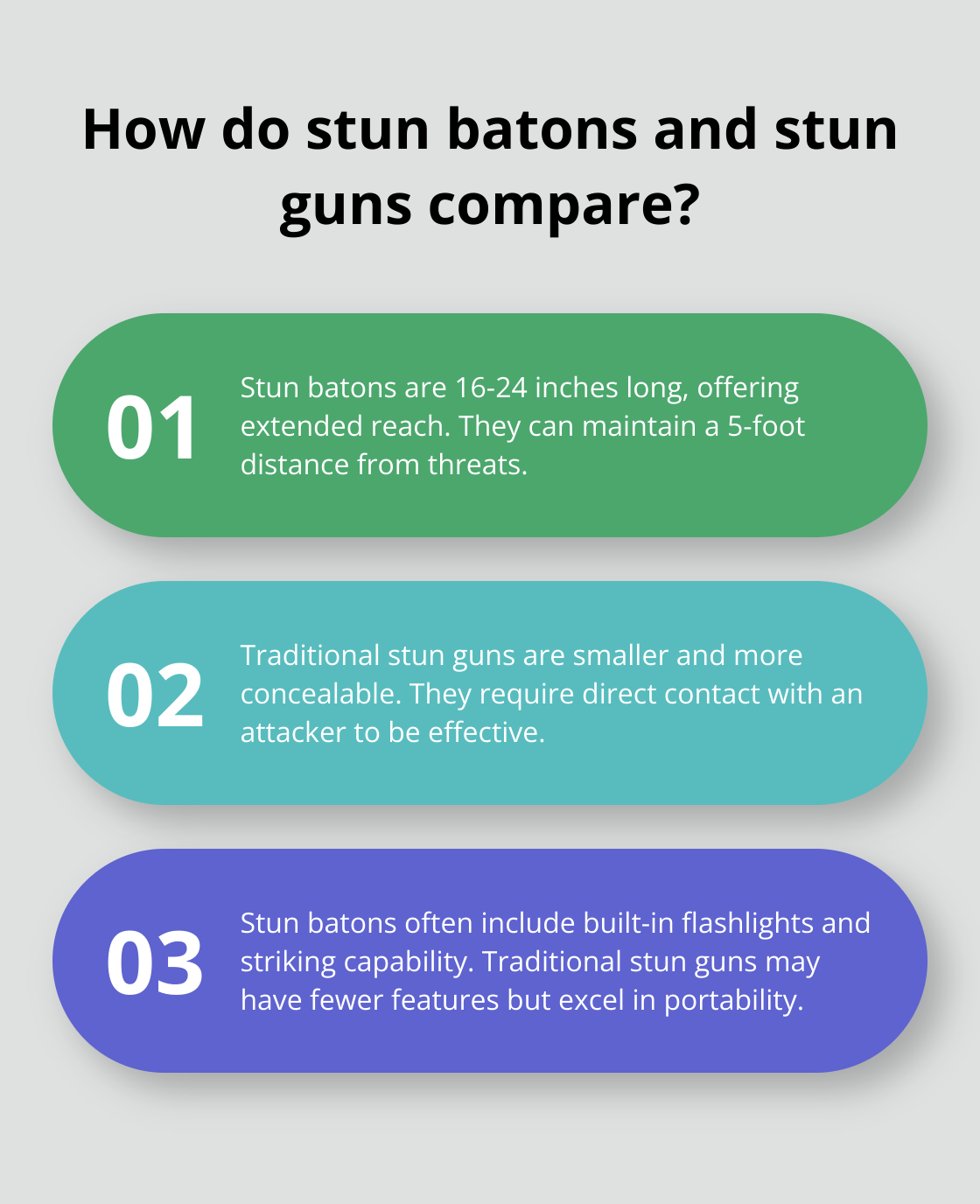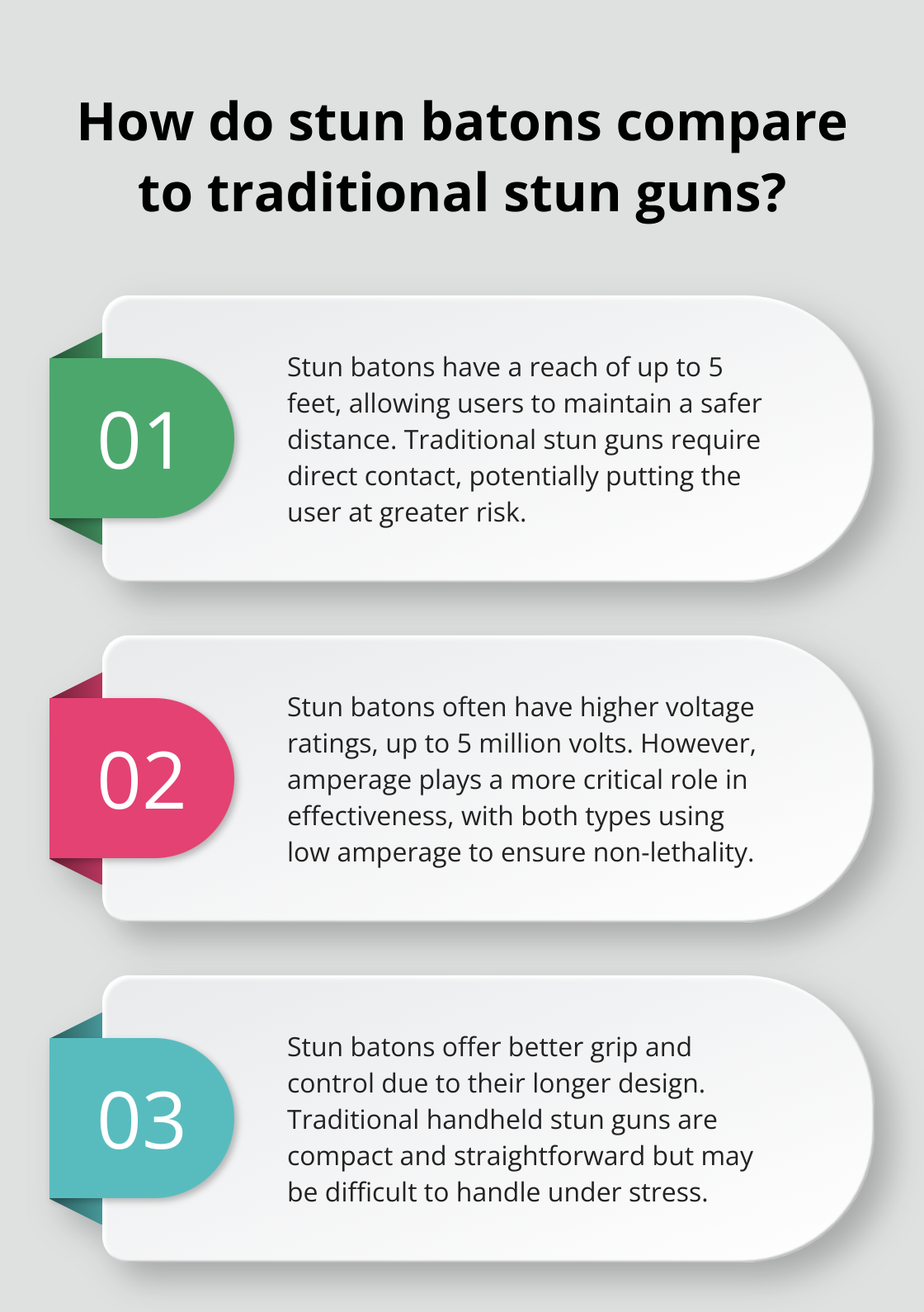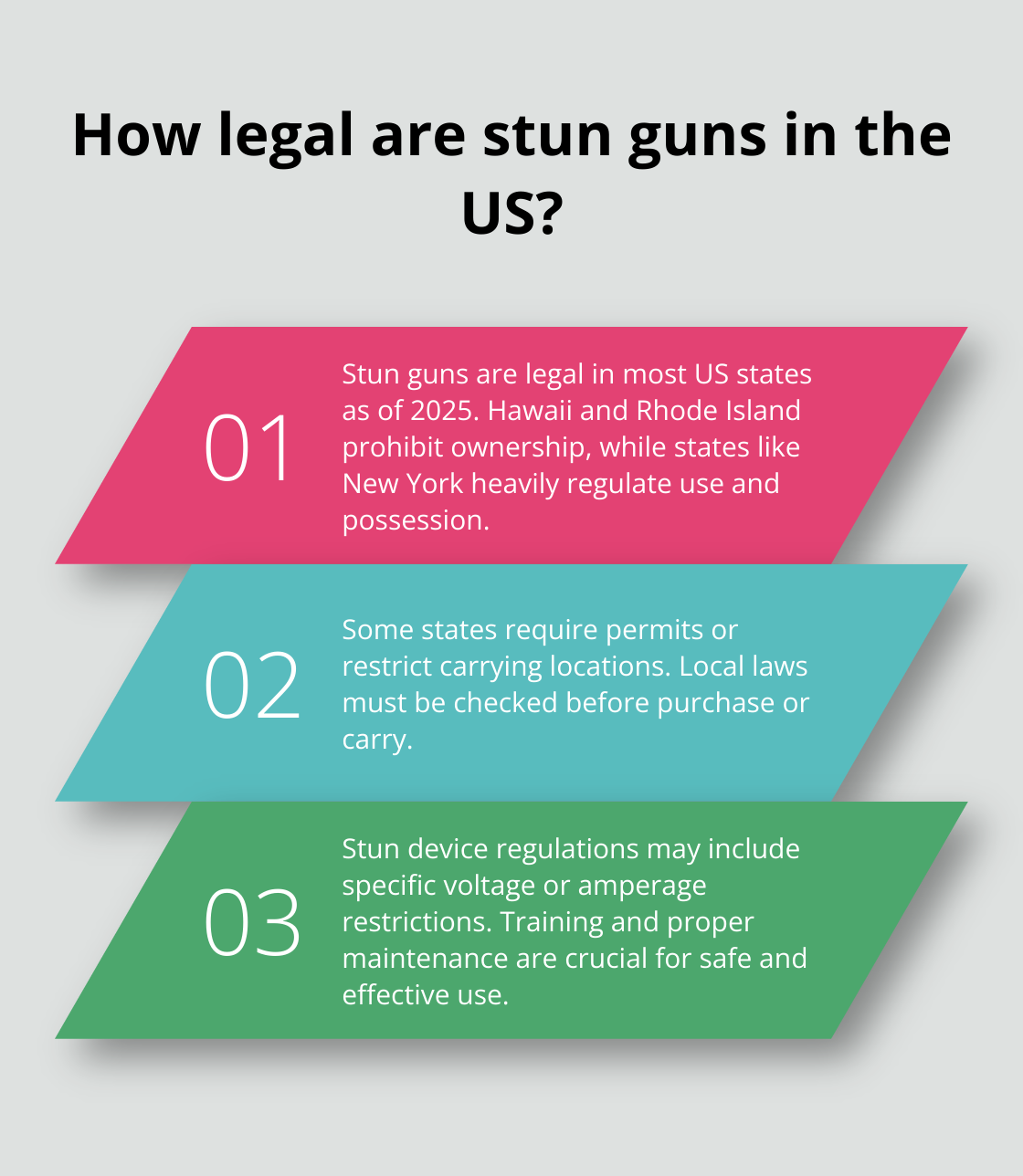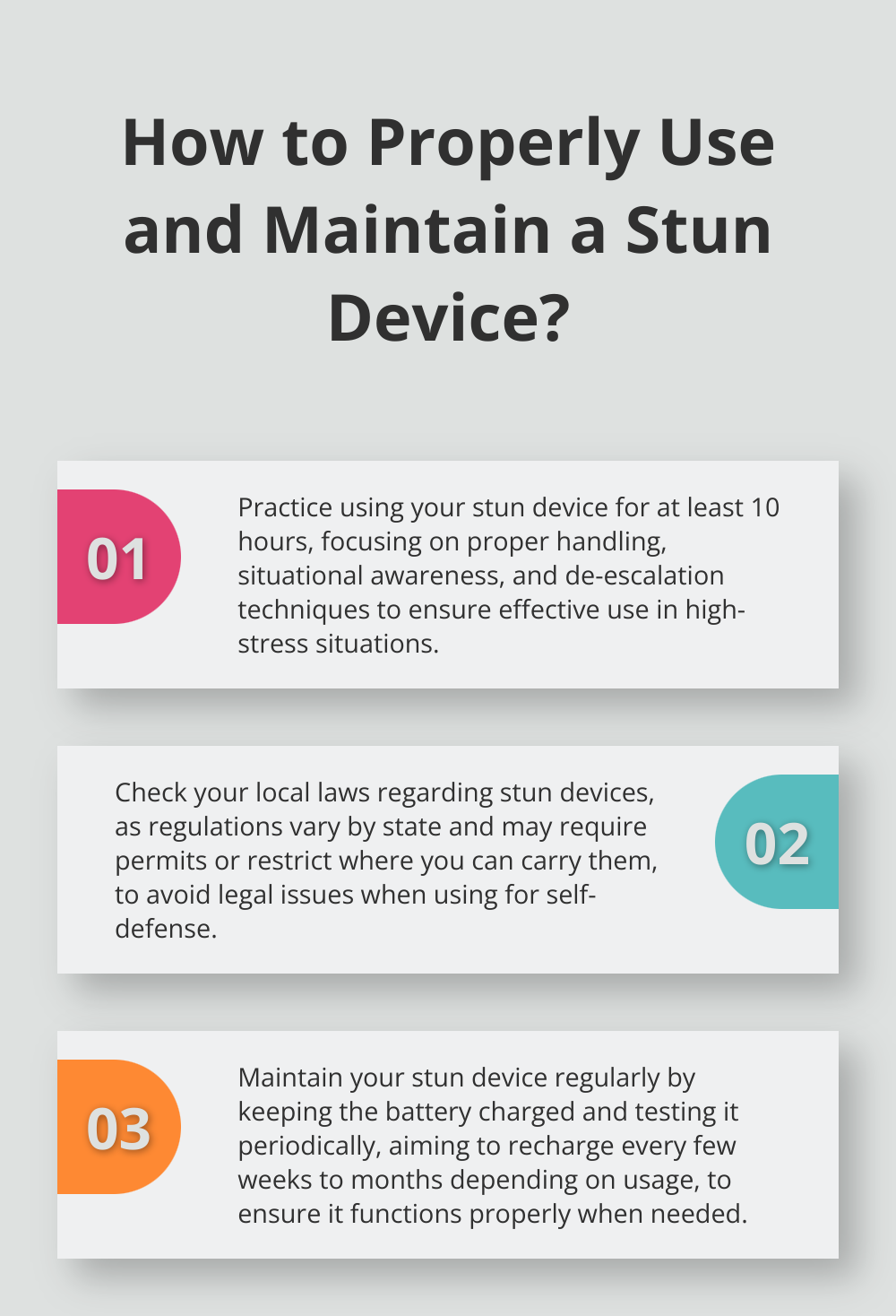Elite Warrior Defense
free shipping on orders over $25
We're having a 15% off sale on all our products. Enter your email below to be notified about future sales.

At Elite Warrior Defense LLC, we often get asked about Taser alternatives for personal protection. Stun batons and traditional stun guns are two popular options, but which one is more effective?
In this post, we’ll compare these self-defense tools, examining their design, power, and practical applications. We’ll also discuss legal considerations and training requirements to help you make an informed decision about your personal safety.
Stun batons are elongated devices (typically 16 to 24 inches long) that deliver a high-voltage, low-amperage shock upon contact with an assailant. Their extended reach allows users to maintain a safer distance from potential threats.

It’s important to note that the effectiveness of stun batons is not solely determined by voltage. The true factors that determine a stun gun’s effectiveness are more complex than just the voltage rating.
Many stun batons include additional features that enhance their utility:
Traditional stun guns are smaller, handheld devices designed for close-quarter self-defense. Smaller stun guns might have fewer features or less power compared to bigger ones, so it’s important to consider your specific needs when choosing a device.
Stun guns require direct contact with an attacker to be effective. When activated, they emit a loud, crackling sound and visible electrical arc between two metal prongs. This audio-visual display can serve as a deterrent even without physical contact.
The primary difference between stun batons and traditional stun guns lies in their range of effectiveness. Stun batons allow users to maintain a distance of up to 5 feet from an attacker, while stun guns necessitate close physical contact.
Stun batons offer more versatility in self-defense situations. Their length provides better leverage and control, and users can use them for striking as well as stunning. This dual functionality can prove advantageous in certain scenarios.
Traditional stun guns excel in portability and concealment. Their compact size makes them easier to carry in a pocket or purse, which can prove crucial for everyday personal protection.
When selecting between these devices, consider your specific needs and circumstances. If you prioritize range and versatility, a stun baton might serve you better. For those who value concealability and ease of carry, a traditional stun gun could be more suitable.
Both stun batons and traditional stun guns have their unique advantages. The effectiveness of each device depends on various factors, including the user’s comfort level, physical capabilities, and the specific self-defense situation. In the next section, we’ll compare the effectiveness of these two devices in more detail, examining factors such as power output, ease of use, and psychological impact.
Stun batons excel in range. With an average reach of up to 5 feet, they allow users to maintain a safer distance from potential threats. This extended reach can deter attackers before they get too close. Traditional stun guns require direct contact, which may put the user at greater risk.
Stun batons often boast higher voltage ratings (some up to 5 million volts), but voltage alone doesn’t determine effectiveness. The amperage, which affects the actual shock delivered, plays a more critical role. Both stun batons and traditional stun guns typically use low amperage to ensure they’re non-lethal.

The National Institute of Justice reports that electro-muscular-disruption (EMD) technology, also known as conducted energy devices (CEDs), have become a less-lethal weapon option in recent years. This gives stun batons a slight edge, as they often deliver higher voltage over a larger contact area.
In a self-defense scenario, simplicity matters. Traditional handheld stun guns are compact and straightforward to use, requiring only a button press to activate. However, their small size can make them difficult to handle under stress.
Stun batons, with their longer design, offer better grip and control. Many users find them easier to wield accurately when adrenaline pumps through their system. The added benefit of using a stun baton as a striking tool also increases its versatility in different scenarios.
The visual impact of a self-defense tool can match its physical capabilities in importance. Stun batons, with their larger size and visible electrical arc, often create a stronger psychological deterrent. The crackling sound and blue spark of an activated stun baton can make an attacker reconsider their actions.
Research suggests that the use of tasers and stun guns has become normalized among urban women, indicating a growing trend in their adoption for self-defense.
While both tools can deter effectively, the imposing presence of a stun baton may prevent confrontations before they escalate to physical contact.
The effectiveness of a self-defense tool depends on individual needs, legal restrictions, and comfort level with the device. Try both options (where legal) to determine which feels more natural and effective for your personal protection needs. Consider factors such as your daily routine, physical capabilities, and local laws when making your decision.
As we move forward, we’ll explore the practical considerations for using these self-defense tools, including legal restrictions, portability, and training requirements.
The United States has complex and changing laws regarding stun devices. As of 2025, stun guns are legal in most states, with a few exceptions such as Hawaii and Rhode Island, which prohibit their ownership. Some states may require permits or restrict where people can carry them. New York, for example, recently lifted its ban on stun guns but still heavily regulates their use and possession.

You must check your local laws before you purchase or carry any stun device. Some states also have specific regulations about the voltage or amperage of allowed devices.
Stun batons, while effective, can challenge users who want to conceal them due to their size. This makes them less suitable for everyday carry in urban environments. Traditional stun guns, being more compact, offer greater portability and ease of concealment in a pocket or purse.
However, the visibility of a stun baton can deter potential threats in certain situations. When hiking or in areas where open carry is acceptable, the visible presence of a stun baton might prevent confrontations before they begin.
Owning a stun device without proper training can endanger both the user and potential attackers. Many self-defense experts recommend at least 10 hours of hands-on training to become proficient with these tools. This training should cover not only how to use the device but also situational awareness and de-escalation techniques.
Stun devices require regular maintenance to ensure they function properly when needed. This includes keeping the battery charged and testing the device periodically. On average, a fully charged stun gun can last anywhere from several weeks to several months with intermittent use.
Durability is another important factor. High-quality stun devices withstand impact and environmental factors. However, cheaper models may fail when exposed to moisture or extreme temperatures. When you select a stun device, prioritize durability to ensure reliability in critical situations.
When purchasing stun devices, it’s essential to choose a reputable provider. Elite Warrior Defense offers a diverse selection of self-defense products (including stun guns and other protective tools). They provide exclusive promotions and free shipping on qualifying orders, making them a top choice for those seeking reliable self-defense solutions.
Stun batons and traditional stun guns serve as effective Taser alternatives, each with unique strengths. Stun batons provide extended reach and versatility, while traditional stun guns excel in portability and concealment. The effectiveness of these self-defense tools depends on the user’s comfort level, physical capabilities, and specific needs.

Proper training enhances personal safety when using any self-defense tool. Users should develop situational awareness and de-escalation skills alongside device proficiency. Local laws and regulations regarding stun devices vary, so staying informed about legal requirements is essential.
Elite Warrior Defense offers a wide range of self-defense products, including stun guns and other protective tools. Our team can help you select the right self-defense solution based on your individual needs (and circumstances). We provide exclusive promotions and free shipping on qualifying orders, making it easier for you to access reliable personal protection devices.